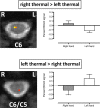Stimulus site and modality dependence of functional activity within the human spinal cord
- PMID: 22553029
- PMCID: PMC6622146
- DOI: 10.1523/JNEUROSCI.2543-11.2012
Stimulus site and modality dependence of functional activity within the human spinal cord
Abstract
Chronic pain is thought to arise because of maladaptive changes occurring within the peripheral nervous system and CNS. The transition from acute to chronic pain is known to involve the spinal cord (Woolf and Salter, 2000). Therefore, to investigate altered human spinal cord function and translate results obtained from other species, a noninvasive neuroimaging technique is desirable. We have investigated the functional response in the cervical spinal cord of 18 healthy human subjects (aged 22-40 years) to noxious thermal and non-noxious tactile stimulation of the left and right forearms. Physiological noise, which is a significant source of signal variability in the spinal cord, was accounted for in the general linear model. Group analysis, performed using a mixed-effects model, revealed distinct regions of activity that were dependent on both the side and the type of stimulation. In particular, thermal stimulation on the medial aspect of the wrist produced activity within the C6/C5 segment ipsilateral to the side of stimulation. Similar to data recorded in animals (Fitzgerald, 1982), painful thermal stimuli produced increased ipsilateral and decreased contralateral blood flow, which may reflect, respectively, excitatory and inhibitory processes. Nonpainful punctate stimulation of the thenar eminence provoked more diffuse activity but was still ipsilateral to the side of stimulation. These results present the first noninvasive evidence for a lateralized response to noxious and non-noxious stimuli in the human spinal cord. The development of these techniques opens the path to understanding, at a subject-specific level, central sensitization processes that contribute to chronic pain states.
Figures







Similar articles
-
Differential fMRI Activation Patterns to Noxious Heat and Tactile Stimuli in the Primate Spinal Cord.J Neurosci. 2015 Jul 22;35(29):10493-502. doi: 10.1523/JNEUROSCI.0583-15.2015. J Neurosci. 2015. PMID: 26203144 Free PMC article.
-
Functional magnetic resonance imaging identifies somatotopic organization of nociception in the human spinal cord.Pain. 2013 Jun;154(6):776-81. doi: 10.1016/j.pain.2012.11.008. Epub 2012 Nov 23. Pain. 2013. PMID: 23618495
-
A quantitative comparison of BOLD fMRI responses to noxious and innocuous stimuli in the human spinal cord.Neuroimage. 2010 May 1;50(4):1408-15. doi: 10.1016/j.neuroimage.2010.01.043. Epub 2010 Jan 22. Neuroimage. 2010. PMID: 20096788
-
Mechanisms of pain in arthritis.Ann N Y Acad Sci. 2002 Jun;966:343-54. doi: 10.1111/j.1749-6632.2002.tb04234.x. Ann N Y Acad Sci. 2002. PMID: 12114291 Review.
-
Diffuse noxious inhibitory controls (DNIC) in animals and in man.Patol Fiziol Eksp Ter. 1992 Jul-Aug;(4):55-65. Patol Fiziol Eksp Ter. 1992. PMID: 1303506 Review.
Cited by
-
Differential fMRI Activation Patterns to Noxious Heat and Tactile Stimuli in the Primate Spinal Cord.J Neurosci. 2015 Jul 22;35(29):10493-502. doi: 10.1523/JNEUROSCI.0583-15.2015. J Neurosci. 2015. PMID: 26203144 Free PMC article.
-
Opioid analgesia alters corticospinal coupling along the descending pain system in healthy participants.Elife. 2022 Apr 26;11:e74293. doi: 10.7554/eLife.74293. Elife. 2022. PMID: 35471139 Free PMC article.
-
Reliability of task-based fMRI in the dorsal horn of the human spinal cord.bioRxiv [Preprint]. 2024 Jun 25:2023.12.22.572825. doi: 10.1101/2023.12.22.572825. bioRxiv. 2024. Update in: Imaging Neurosci (Camb). 2024 Aug 22;2:imag-2-00273. doi: 10.1162/imag_a_00273. PMID: 38187724 Free PMC article. Updated. Preprint.
-
Lateralization of cervical spinal cord activity during an isometric upper extremity motor task with functional magnetic resonance imaging.Neuroimage. 2016 Jan 15;125:233-243. doi: 10.1016/j.neuroimage.2015.10.014. Epub 2015 Oct 18. Neuroimage. 2016. PMID: 26488256 Free PMC article.
-
Functional magnetic resonance imaging of the cervical spinal cord during thermal stimulation across consecutive runs.Neuroimage. 2016 Dec;143:267-279. doi: 10.1016/j.neuroimage.2016.09.015. Epub 2016 Sep 9. Neuroimage. 2016. PMID: 27616641 Free PMC article.
References
-
- Agosta F, Valsasina P, Rocca MA, Caputo D, Sala S, Judica E, Stroman PW, Filippi M. Evidence for enhanced functional activity of cervical cord in relapsing multiple sclerosis. Magn Reson Med. 2008;59:1035–1042. - PubMed
-
- Bouwman CJ, Wilmink JT, Mess WH, Backes WH. Spinal cord functional MRI at 3 T: gradient echo echo-planar imaging versus turbo spin echo. Neuroimage. 2008;43:288–296. - PubMed
-
- Brooks JC, Beckmann CF, Miller KL, Wise RG, Porro CA, Tracey I, Jenkinson M. Physiological noise modelling for spinal functional magnetic resonance imaging studies. Neuroimage. 2008;39:680–692. - PubMed
-
- Brooks JC, Zambreanu L, Godinez A, Craig AD, Tracey I. Somatotopic organisation of the human insula to painful heat studied with high resolution functional imaging. Neuroimage. 2005;27:201–209. - PubMed
Publication types
MeSH terms
Grants and funding
LinkOut - more resources
Full Text Sources
Medical
Miscellaneous
